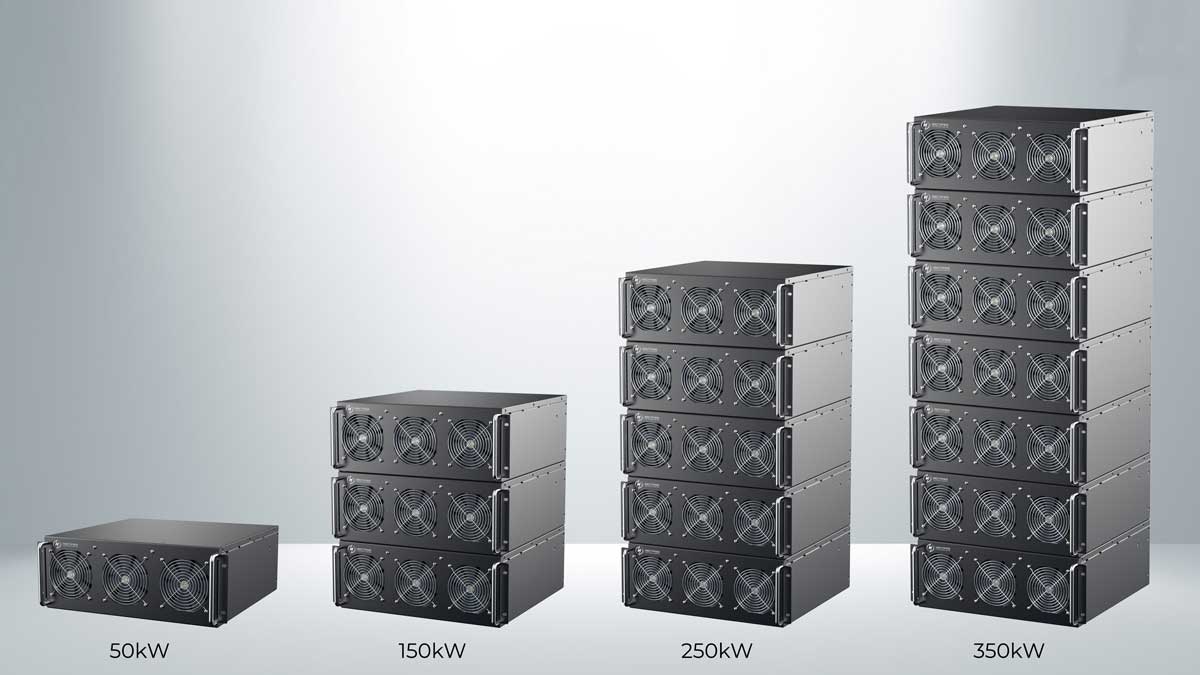RT22 EV charger module is rated at 50kW, but if if a manufacturer wants to create a 350kW high powered charger, they can simply stack seven RT22 modules.
Rectifier Technologies
Rectifier Technologies’ new isolated power converter, the RT22, is a 50kW electric vehicle (EV) charging module which can be simply stacked to increase capacity.
The RT22 also has reactive power control built into it, which reduces grid impact by providing a mechanism to regulate grid voltage levels. The converter opens the door for charger manufacturers to engineer High Power Charging (HPC) or fast charging suitable for city centres too, as the module is compliant to a number of standardised class categories.
The converter boasts an efficiency of more than 96% and a wide output voltage range between 50VDC to 1000VDC. Rectifier says this enables the converter to cater to battery voltages of all EVs currently available, including electric buses and new passenger EVs.
“We have put in the time to understand the pain points of HPC manufacturers and engineered a product that addresses as many of those issues as possible,” Nicholas Yeoh, Director of Sales at Rectifier Technologies, said in a statement.
Decreased grid impact
As High Powered DC charging networks of a similar size and power are rolled out across the world, electricity networks will be placed under increasing strain as they draw large and intermittent amounts of power which may cause voltage fluctuations. To add to this, network operators face difficulty installing HPCs without expensive network upgrades.
Rectifier says the RT22’s reactive power control remedies these issues, reducing network costs and offering greater flexibility in installation locations.
Increased High Powered Charging demand
Each RT22 EV charger module is rated at 50kW, with the company saying it is strategically sized to meet the defined power classes of DC Electric Vehicle chargers. For example, if a HPC manufacturer wants to create a 350kW high powered charger, they can simply connect seven RT22 modules in parallel, within the power enclosure.
“As electric vehicle adoption continues to increase and battery technologies improve, the demand for HPCs will consequently rise as they play a key role in the facilitation of long distance travel,” Yeoh said.
“The most powerful HPCs today sit at around 350kW, but higher capacities are being discussed and engineered to prepare for the electrification of heavier vehicles, such as freight trucks.”
Opening the door for HPC in urban areas
“With Class B EMC compliance, the RT22 can start from a lower noise foundation and thus be more suitable to being installed within an urban environment where electromagnetic interference (EMI) must be limited,” Yeoh added.
Currently, HPCs are mostly confined to highways, but Rectifier believes as EV penetration grows, so too will the demand for HPCs in urban centres.
“While the RT22 alone does not ensure the entire HPC will be Class B compliant – as there are many other factors beyond power supply that affect EMC – it makes sense to offer it at the power convertor level first and foremost,” Yeoh said. “With a compliant power converter, it is more possible to create a compliant charger.
“From the RT22, HPC manufacturers have the foundational piece of equipment required for charger manufacturers to potentially engineer a HPC suitable for urban areas.”
Post time: Oct-31-2023

 Portable EV Charger
Portable EV Charger Home EV Wallbox
Home EV Wallbox DC Charger Station
DC Charger Station EV Charging Module
EV Charging Module NACS&CCS1&CCS2
NACS&CCS1&CCS2 EV Accessories
EV Accessories

